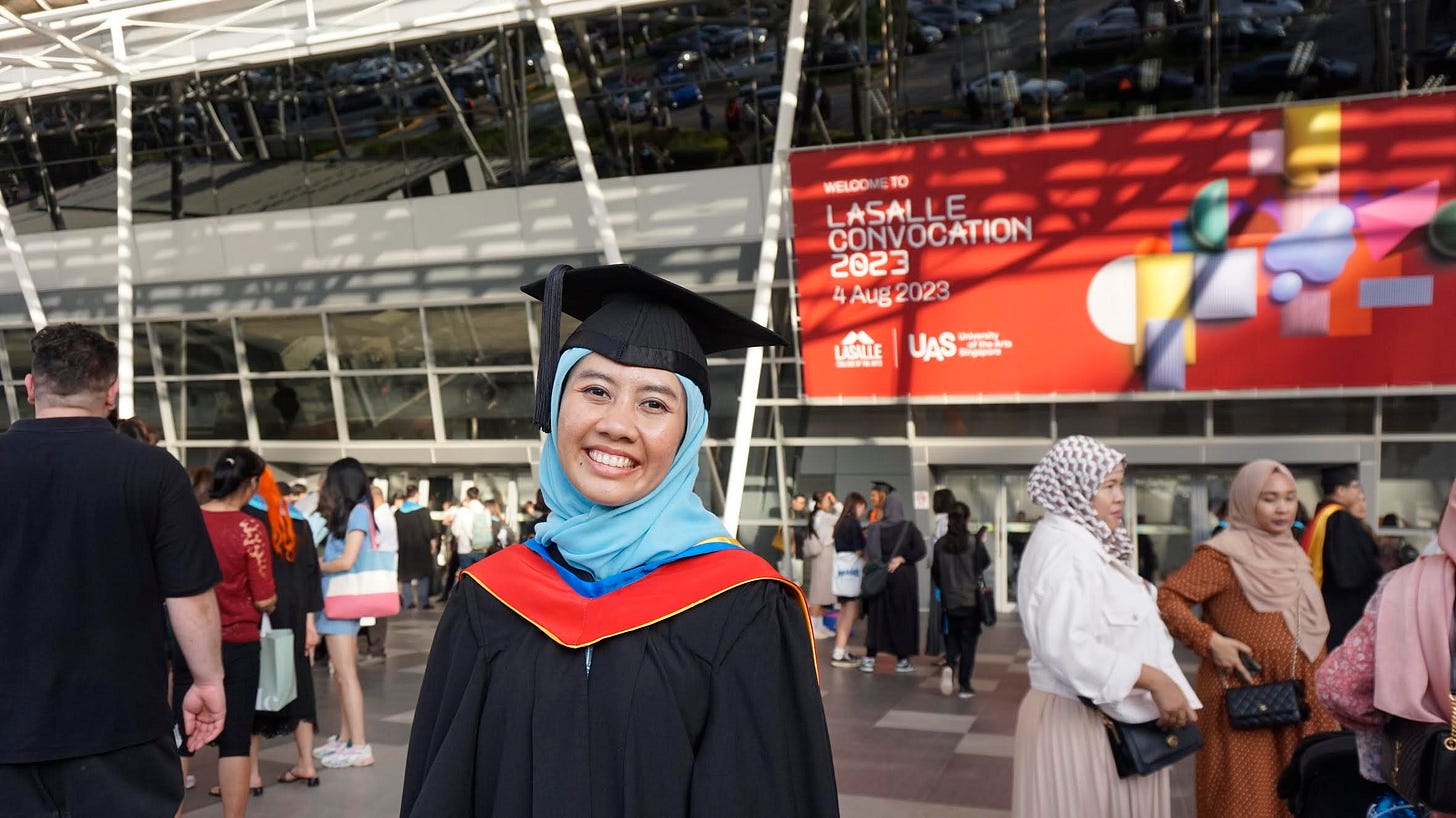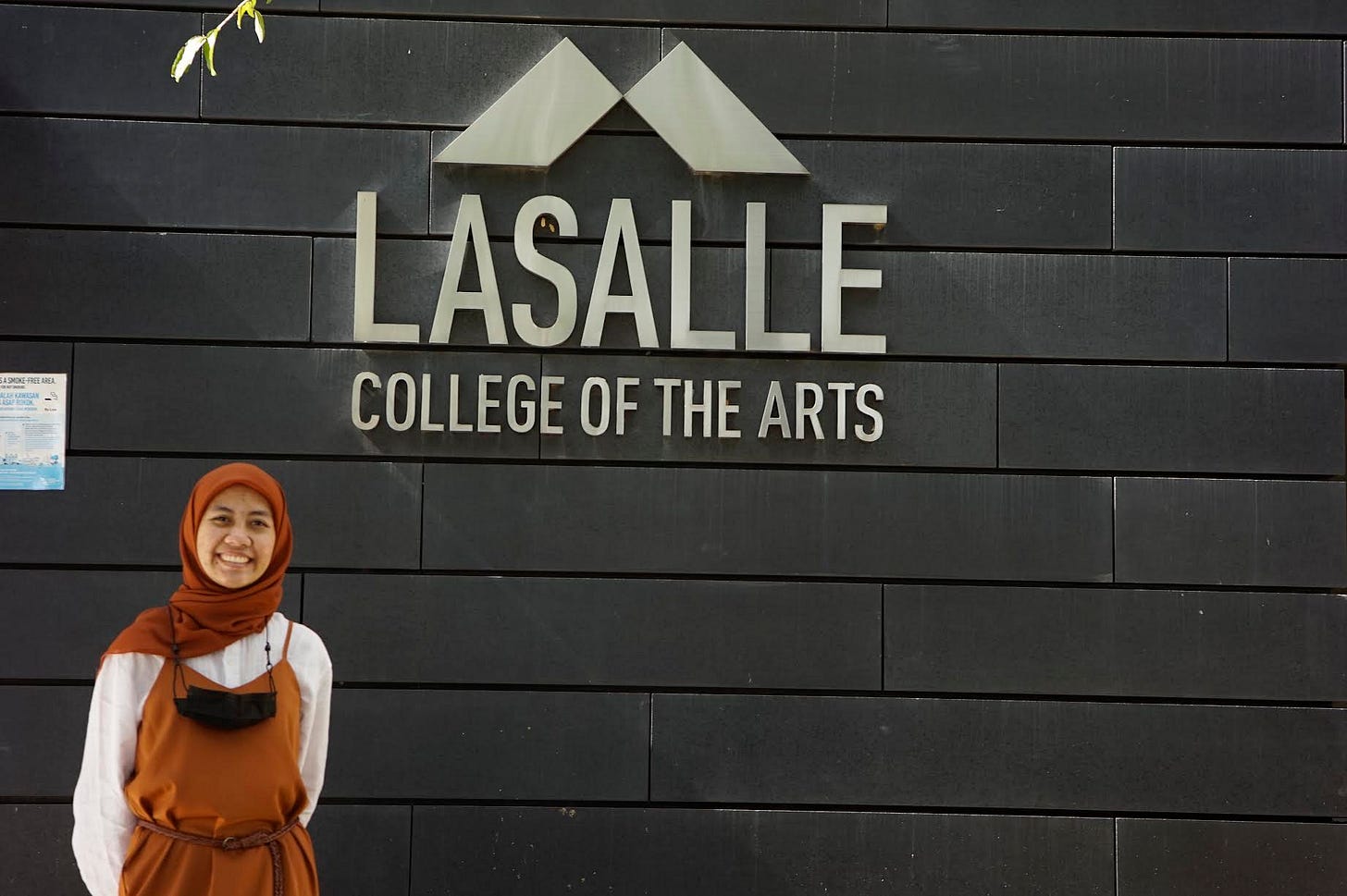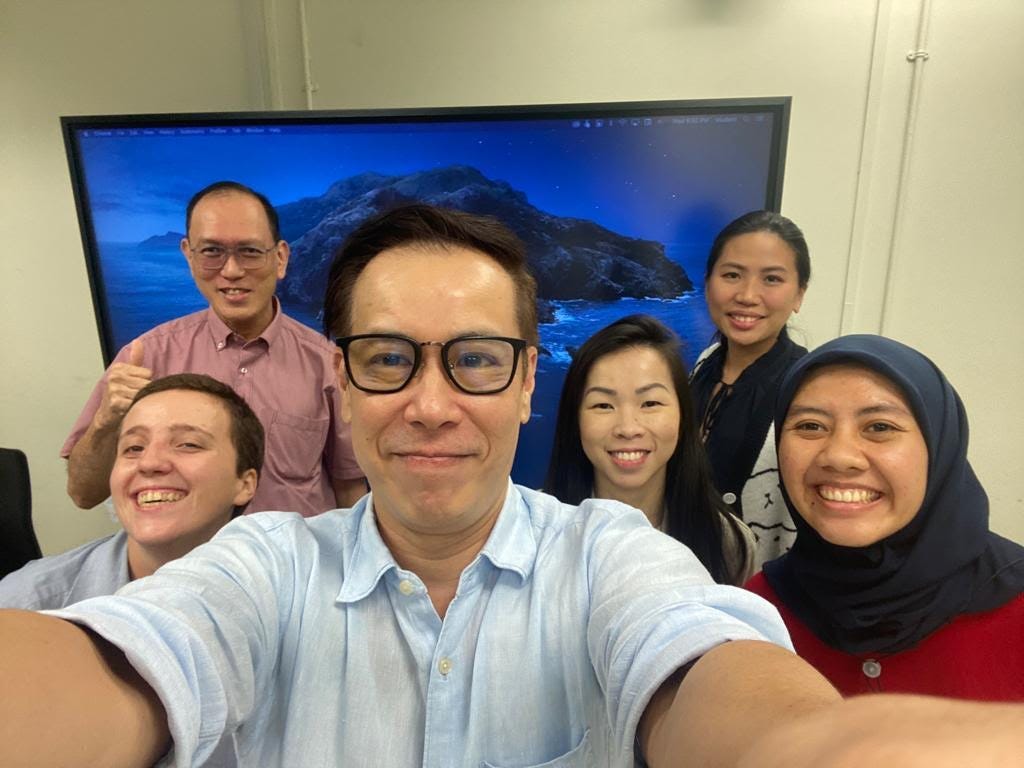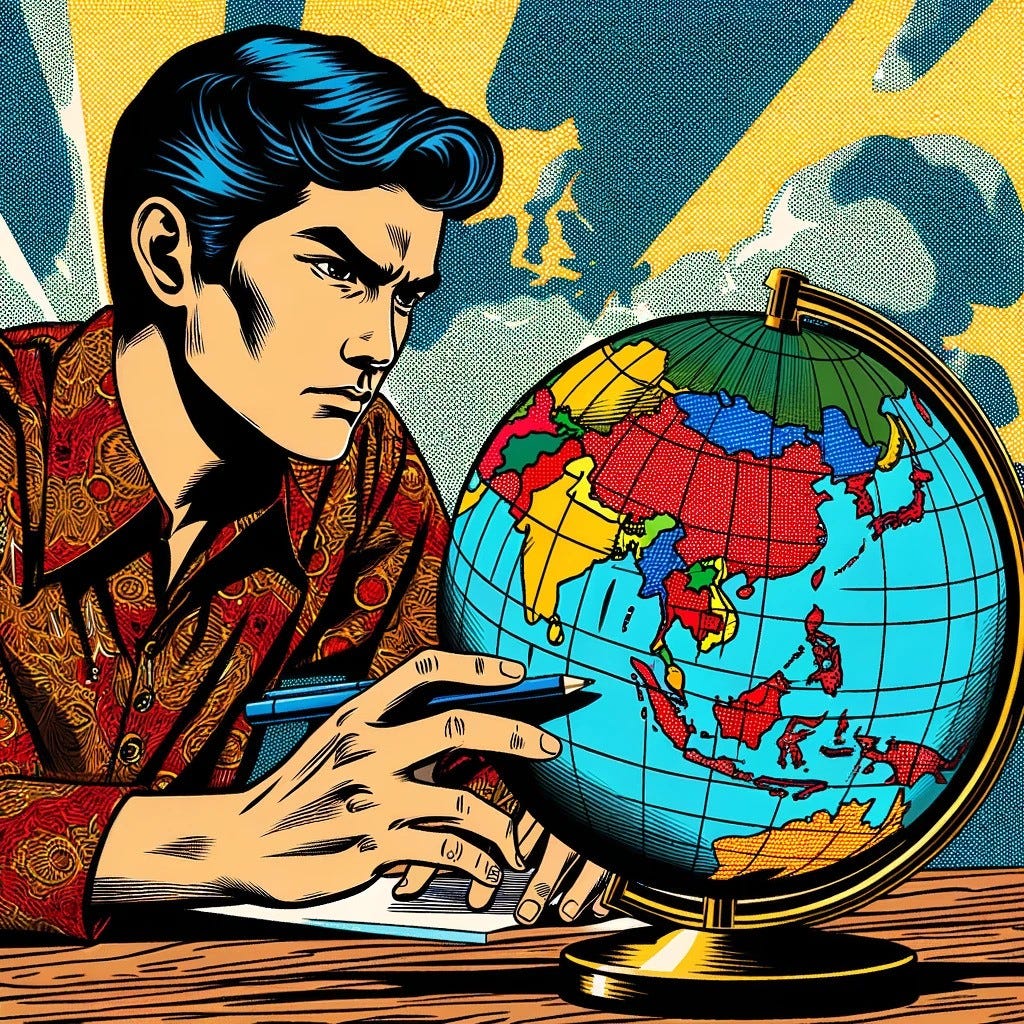#11: Going the distance for passion
Amirahvelda’s unwavering pursuit of art history, and her journey along a road less taken.
Welcome to this week’s edition of SEAmplified! Your latest insights on Southeast Asian youth and youth politics in 9.5 minutes.
⌛This week in brief:
📌 How this Indonesian Millennial chased her calling from Surabaya to Singapore
📌 This week, Seamplified: 9th April 2024 MEET THE SEA YOUTH
“Meet the SEA Youth” features ordinary youths in Southeast Asia (SEA) who are venturing within the SEA region, reflecting the current aspirations of these youths, while offering fresh perspectives on the diversity of opportunities in SEA.This Indonesian millennial chased her calling from Surabaya to Singapore.
“Art without philosophy is just decoration,” declared Amirahvelda (“Velda”) Priyono, a 29-year old Indonesian whose love for art history took her on a long journey from Surabaya to Singapore.
But art history wasn’t always Velda’s obsession. She had studied French linguistics and literature in college, and initially aspired to study abroad in Paris before becoming a career diplomat. But a series of events derailed her plans - and set her down a path towards new ones.
That doesn’t mean that Velda has abandoned her goal of reaching Paris someday. Coming to Singapore was a temporary detour, and the experiences she has gained here have clearly set her on a better footing for bigger things ahead. Read on to find out more about her journey with art history, and her thoughts on choosing a path less taken.
All images courtesy of Amirahvelda Priyono.
Grabbing chance by the horns
My foray into art history was a fortuitous one.
It began back in December 2016. I had just graduated from college, and wanted to pursue a master’s abroad in Paris.
But all of my applications fell through, and the path that I’ve always wanted for myself suddenly seemed so distant and out of reach.
That year, Bank Indonesia introduced several new banknotes that featured some of the country’s most prominent national heroes.
One hero, in particular, attracted some controversy from the Indonesian public: Frans Kaisiepo, a native Papuan and former fourth governor of Indonesia’s Papua Province. His detractors called him “ugly” and “monkey-like.” The online vitriol got quite intense.
Where do such reactions come from? I personally believed that they stemmed from a lack of awareness of Indonesia’s cultural diversity. Indonesia is comprised of many ethnic communities, but many of their stories are not told well by museums in Indonesia.
That set my sights on art history. But opportunities to study art history were far and few between in my home city of Surabaya (I did find out much later that there is, in fact, a thriving community of art collectors based there). I remember a conversation I had with my program leads at Lasalle College of the Arts - they actually felt sorry for me once I told them where I’d come from!
I had zero experience with art history, and had no network to tap upon. So I rolled up my sleeves and got started. I took up online courses to pick up the fundamentals, as well as a part-time stint as a museum admissions officer at Museum MACAN in Jakarta; my evenings were filled art curator gatherings and webinars.
One hack that accelerated my progress: looking up and connecting with art collectors and curators who are following the Instagram handles of art galleries. That’s how I landed an internship researching Indonesian artists for a Paris-based art gallery.
During this period, I also connected with a Singaporean on Linkedin. I noticed that he had graduated from Lasalle a while ago - that was my first time hearing about the school.
On the list of programs on offer was self-funded course on Asian Art History. Something in me shouted: “This is it!” Money wasn’t a problem - all I had to do was clinch Lasalle’s SEAsia Scholars Award. It’d cover 98% of tuition fees, and some part-time work on the side ought to take care of the rest.
With applications closing within a month, I rushed out all of the paperwork - cover letter, referrals, IELTS test scores and so on - as fast as I could. That was an emotionally testing period, but my biggest test was yet to come.
You see, my parents didn’t support my decision to pursue art history. They thought I was being wishy-washy, callously jumping from one career aspiration to the next. So I hid my decision to study in Singapore from them, right up till the night after I had submitted my application.
At dinner, I drummed up my courage and broke the news. There was a brief interrogation of sorts, but they were surprisingly receptive to it. They were happy for me, and the rest was history.
Finding art and self in Singapore
As they say, getting in is the easy part.
I knew that Singapore had a lot more potential than Surabaya - there’s a greater openness and richness of culture here, and there’s also a thriving art market that promised many career opportunities.
But deep down, I was afraid that Singapore would be a very lonely experience for me. It’s also very expensive, and I feared that just surviving there would be a struggle.
There was also a fear that going this far could be for nothing. If I don’t - or can’t - get a job after this, am I useless?
Most of my course peers were already seasoned art professionals, and I was deeply insecure about my own lack of a track record. Applying for a job in Indonesia also gets much more difficult once you’re between 30 to 35 years old. As I grappled with this dilemma, I also had to rebuff my family’s calls to come home, get married, and start a family.
Walking this journey alone is tough, and I was fortunate enough to find a home away from home, in the people who support me along the way.
One of them was the son of my mum’s friend, who worked at Singapore’s Nanyang Technological University (NTU). At first, I would go to the NTU campus to meet up with him. But I gradually made so many new friends there, and even got roped into weekly badminton sessions with them.
Honestly speaking, I’ve been to NTU so many times that I know their campus layout better than Lasalle’s.
I also had the privilege of meeting one of NTU’s ex-Provosts. When I met him, I was contemplating whether my thesis had any practicality to it. To that, he said: “Nobody will know about your thesis if it’s just hung up on a website, write in a well-published journal and pursue a PhD.” The last part was quite a leap, but the gist of what he said to me still resonates with me today.
And the webinars I previously joined? I also met some of the speakers in person once I got to Singapore, and many of them dropped me a warm connection to other art history professionals.
One of the connections that really struck me was Mr. Dinh Q. Le, a vietnam war veteran who also witnessed the atrocities committed by the Khmer Rouge. My conversation with him made me realize how differently our lived experiences shape our perception of the world around us; It made me realize that there’s a diversity of stories out there, and that perhaps I’ve been watching too many Hollywood movies.
Thank god for Netflix.
Rewards of a road less taken
This whole experience has greatly refined how I view who myself.
As a fresh graduate, I still dreamt of a career in international relations. But I now realize that international relations was only a personal interest, and it wasn’t deep enough to fuel a career in it.
I also used to follow in the footsteps of many people, and I felt that I lacked my own identity as a person. But I’ve now realized that all the seemingly unrelated career choices that I’ve made over the years are, in fact, driven by the same likes and values that make me who I am.
Coming to Singapore has also made me re-evaluate my relationship with home. It’s not that I dislike living there; I’ve met a lot of people and made a lot of memories in Surabaya, but there’s more than just this story to life and I want to see another side of the world.
This experience has also reshaped my desire to pursue further studies in Europe. I’m now deeply interested in how Europeans perceive post-independence Indonesia through art, and how those perceptions shape diplomacy and trade between the two. I like to think of it as giving another perspective for society to think about topics like mutual aid, and education.
But art history is also deeply personal. In some moment, someplace in time, someone decided to document an incident on canvas. It reveals something close to their heart. That’s why to me, when you talk about art, you talk about your personality.
Know a Southeast Asian youth who’s working, studying, or living in another Southeast Asian country, or are you doing so and would like to share your story? Email the editors at tanzhantiam@gmail.com or tianwen.tay@seakoel.com
If you enjoyed today’s article, follow SEAmplified on Instagram and LinkedIn, hit the subscribe button below, or email the editors if you have any feedback for us!
News roundup
Indonesian telco giant Ooredoo Hutchison will partner US tech giant Nvidia to build a US$200 million artificial intelligence center in the central Javan city of Surakarta. Nvidia’s aggressive Southeast Asian push reflects growing data demand fuelled by the region’s burgeoning digital economy.
Laos’ Labor Ministry has urged its citizens to apply for local jobs amid a severe domestic labor shortage. The appeal addresses the trend of Laotian youths seeking higher wages abroad, as local firms struggle to offer competitive wages amid high inflation and currency depreciation.
Malaysia’s former Prime Minister Najib Razak has filed a bid to serve his remaining jail term under house arrest. This comes after Malaysia’s former king granted Najib a reduction in jail term and fine, which sparked an outcry amongst activists and observers against a home detention plan for selected prisoners.
The Philippines has suspended in-person classes in thousands of schools, as temperatures rose to 42 or 43 degrees Celsius in several parts of the country. The lack of air conditioning in many schools has also made it challenging for students to focus in the intense heat.
Singapore plans to build a pool of 100 nuclear energy experts, though no specific timeline has been given. The pool will include local talents trained and sent overseas to study the latest nuclear energy developments.
Thailand’s Chiang Mai province has seen over 30,000 people treated for air pollution-related diseases in the first three months of this year. Several villages have also been declared public disaster zones as forest fires continue to ravage the province.
Vietnam’s youths are increasingly seeking employment in Europe instead of traditional markets such as Japan and South Korea. Higher pay, better welfare and benefits, as well as lower work entry requirements were cited as key reasons for the shift.
Community highlights
32% of all electricity in Southeast Asia is already generated by renewables. But data from Stanford’s Walter H. Shorenstein APAC Research Center paints a more sobering picture: regional electrification could take more than 26 years to catch up to developed standards.
Our friends at ISEAS have recently rolled out their 2024 State of Southeast Asia Survey report, and it’s a treasure trove of insights. What caught our attention: while most respondents picked China over the US, nearly half of them also expressed distrust towards China.
AI is shaking things up across Southeast Asia, and the region’s startup ecosystem is no exception. Singapore-based HR tech startup Glints’ latest report in collaboration with Monk’s Hill Ventures explores the latest talent trends in the region amid challenges old and new.







